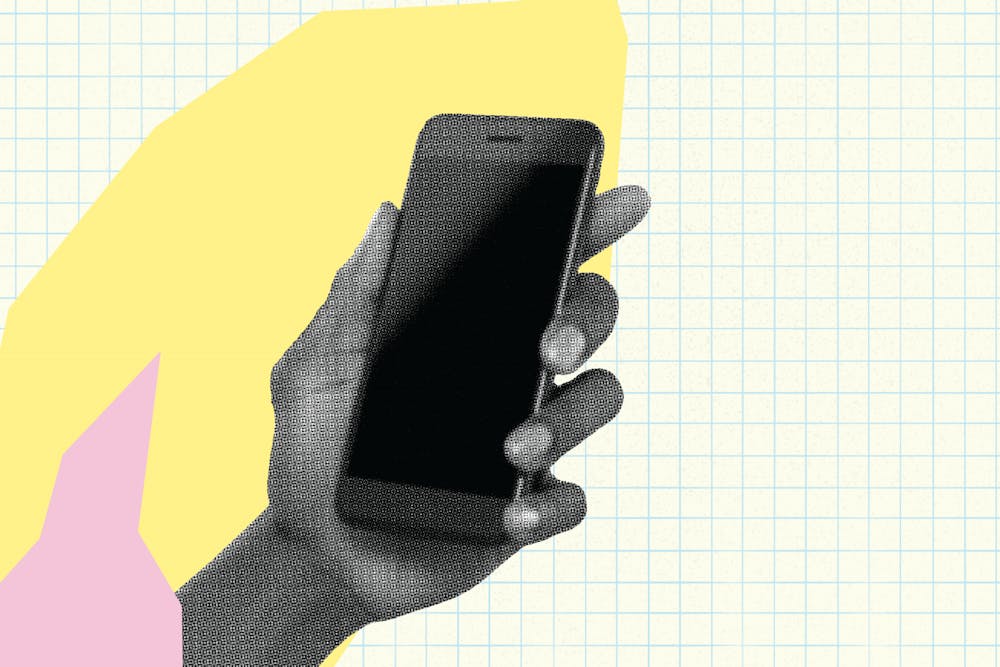I have spent far too much of the pandemic on my phone.
I never even downloaded TikTok—I knew it would be too addictive—but I still managed to clock four, six, eight–hour screen times every few days on other social media platforms. So I deleted all of them. Still, multiple times per day, I found myself picking up my phone and staring at my lock screen, like I was asking it to entertain me. I’d open it and swipe across my home screens, open and close my emails and messages, or play half a level in a few mobile games, only to eventually set it back down, unsatisfied. And because I was never satisfied, I kept going back, and back, and back again rather than doing something engaging. Even without social media, my screen time was still so much higher than I wanted it to be; the wasted hours on my phone were certainly contributing to how much I was drowning academically. I needed to do something more than delete all my apps.
So I turned my phone black and white.
As much as this sounds like a hipster aesthetic choice, it was a practical one. I discovered the idea in blog pieces (much like the one I'm writing now) touting the efficacy of the grayscale setting on lowering screen time. This trick is based on the fact that most smartphone features and apps are designed to trigger dopamine receptors in the brain, creating enjoyment that motivates us to continue using our devices. While the content and user experience of these apps do most of the neurological work to attract us, a significant part of the appeal is the constantly changing candy colors of our phone screens. In this way, we're all large toddlers with much techier versions of a LiteBrite. Removing the colors supposedly removes some of the neurological appeal. While I can’t personally speak to the science behind the matter, I can describe my experience, which suggests that the allure of digital color is real.
With my phone in grayscale mode, I find myself turning to it only when I actually want to use it for a specific purpose—to look something up, read a message or email, or check the time. Far less often do I find myself picking it up idly, and when I do I’m able to consciously tell whether I’m actually seeking something specific, like a particular game, or an addictive hit that I won’t find. This change has made me realize how much digital design is dependent on color rather than accentuated by it; so many of the games I play are much more difficult without the speed of color recognition to assist me. As a challenge, I tried playing a color–matching puzzle game, comparing the different grays to one another. I was not very good at it.
I’m also becoming more aware of how much I view my life through my smartphone. Now, the first thing I look at in the morning and the last thing I look at at night is black and white. My gray Green Passes have become a daily inconvenience. (If you’re curious, they can still be checked through the “Cleared” banner at the top.) Taking photos in grayscale makes me much more likely to photograph things I want to remember, since the act feels like documentation more than aesthetic preservation. Possibly the most unsettling side effect of this exercise is that my imagination is often in black and white. When I look up from my screen, sometimes the real world seems black and white, too. I couldn’t write a better metaphor about the impact of my smartphone if I tried.
Sometimes, I put my phone back into color—when watching YouTube videos, for example, or shopping online. And occasionally, I pick up my phone and poke around, some part of my brain still begging to be entertained without effort. Even though it’s partially my responsibility as a consumer to be disciplined, I’m fundamentally aggrieved that it's on me to use tricks to protect myself rather than on tech companies to fix their neurologically–damaging products.
I think I’m going to leave my phone in black and white, and maybe even test out the setting on my laptop. It’s not a perfect solution, but for the sake of my attention span, my grades, and my happiness, it’s a worthwhile one to me.
To put an iPhone in Grayscale mode: Open your Settings and tap on Accessibility. Within the Accessibility menu, tap on Display and Text Size, then scroll to the Color Filters tab. Tap on the Color Filters tab to open a submenu with an image of colored pencils across the top. Switch the Color Filter setting from Off to On, and your phone will instantly enter black and white mode. There are also other color filter options besides the default Grayscale. The smartphone I reference in this piece is an iPhone SE 2020.
To put an Android phone in Grayscale Mode: The quickest way to do this is to open your settings and tap on Digital Wellbeing. Then, tap on Wind Down, select Use Wind Down, and toggle on the Grayscale setting under Wind Down Settings. You can disable the other Wind Down settings to use Grayscale Mode throughout the day. Grayscale Mode can also be turned on through the developer settings. On newer Androids, a Grayscale toggle can even be included in the Quick Settings menu, to turn on and off easily.

